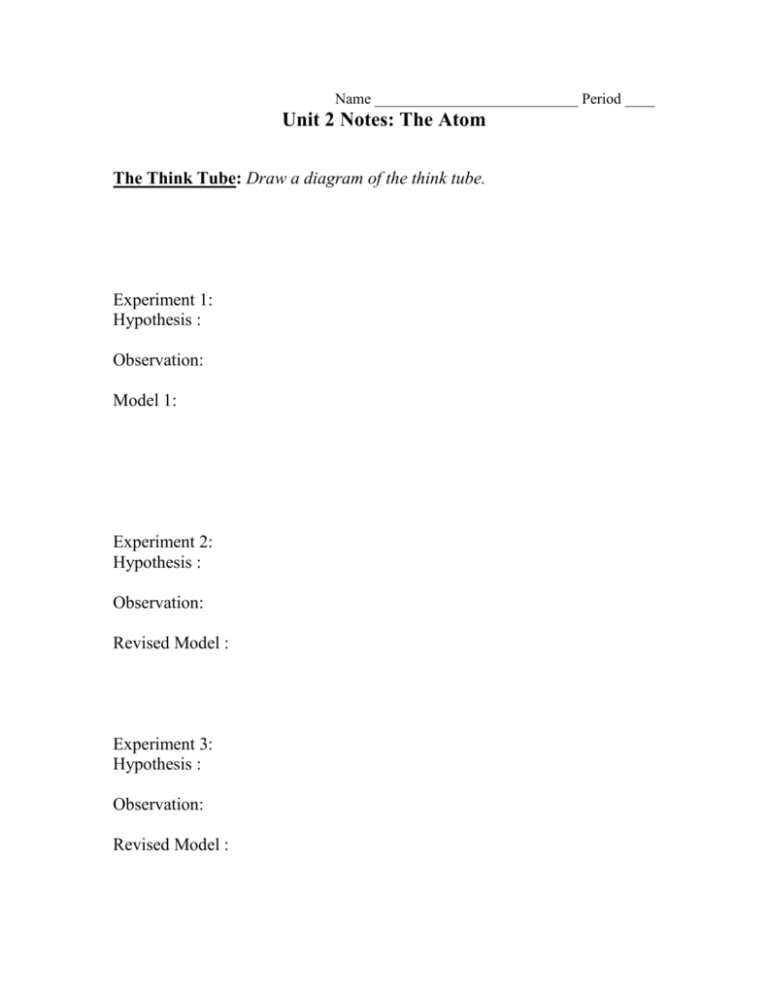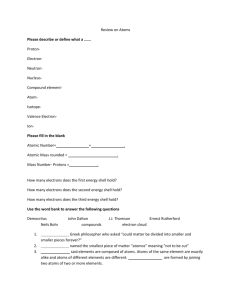File
advertisement

Name ___________________________ Period ____ Unit 2 Notes: The Atom The Think Tube: Draw a diagram of the think tube. Experiment 1: Hypothesis : Observation: Model 1: Experiment 2: Hypothesis : Observation: Revised Model : Experiment 3: Hypothesis : Observation: Revised Model : The History of the atom: 1. Ancient Greek Philosophy Debate 2. Democritus (400 BC) 3. Aristotle (350 BC) 4. Shift from pure __________ to ________________ evidence. a. Law of Conservation of Mass b. Law of Definite Proportions c. Law of Multiple Proportions 5. John Dalton (1808): Atomic Theory of Matter “Billiard Ball Model” a. All Matter is composed of extremely small particles called atoms. b. Atoms of a given element are identical in size, mass, and other properties; atoms of different elements differ in size, mass, and other properties. c. Atoms cannot be subdivided, created, or destroyed. d. Atoms of different elements combine in simple whole-number ratios to form chemical compounds. e. In chemical reactions, atoms are combined, separated, or rearranged. How small is small? 6. J.J. Thompson (1890’s) 7. Lord Kelvin (1890’s) 8. Enerest Rutherford (1911) 9. James Chadwick (1932) 10. Rutherford’s Model of the Hydrogen Atom (1911) Proportions: Problems with Rutherford’s model Three Types of Subatomic Particles: Protons. Neutrons Electrons Reading the Periodic Table: Atomic number Mass number Average Atomic Weight Isotopes Valence Electrons Ions Period Group number Another Revision of the Atomic Model: 11. Bohr’s Model (1913): Niels Bohr takes a new look at electrons: Electrons sometimes act like particles, but sometimes act like a ____________. Spring Demo: Since an electron acts like a wave, it can only orbit the nucleus at ______________ ________________. Therefore, electrons can only have certain _________________. Light Spectroscopy Demo: Flame Test Lab: Properties with specific allowed values and forbidden values are called ______________. Electrons have quantized positions and quantized energies. Describing the Location of Electrons Why do we care where the electrons are? We want to know how many _______________ _______________ an atom has so we can predict what bonds it will make. We describe the location of electrons in terms of __________, _______________, and _______________. Where can electrons be? 1. 2. 3. 4. 5. 6. 7. Analogy: Each ____________ is like a _______________ in a _______________. Each _______________ is like an _______________ on that floor. Each _______________ is like a _______________ in that apartment. Each room has _______ beds. Electrons are like _______ ________. Old men live by simple rules. 1. Old men do not want to _______________ a room. 2. Old men do not want to _______________ up stairs. 3. They would rather Notation: Examples: 1H: 2He: 3Li: 3s2 Practice: Overlapping Subshells: Up to element 18, the electrons fill the electron shells in the order that we might predict. Consider the shapes of the s, p, d and f subshells. How can we remember the exceptions to the rule? Noble Gas Shortcut: Orbital Diagrams Consider ions and electrons in a non ground-state. Distinguishing electron – Diamagnetic – Paramagnetic – Periodic trends 1. Atomic Radius – Increase a lot Why? Increase a little bit Why? 2. Electronegativity – Increase a lot Why? Increase a little bit Why? 3. Ionization energy – Increase a lot Why? Increase a little bit Why? How do electronegativity and ionization energy differ? Determining the Number of Valence Electrons: Octet Rule: Bonding Trends: 1. Group ___ elements are called _______________ _______________ 2. Group ___ elements are called _______________ ___________ ______________ 3. Group ____ elements are called _______________. 4. Group ____ elements are called _______________ _______________. 5. Metals 6. Nonmetals 7. Metalloids






